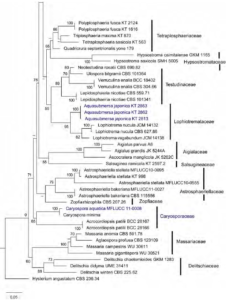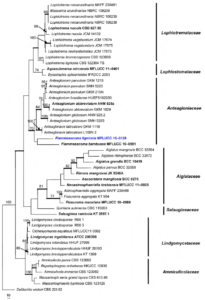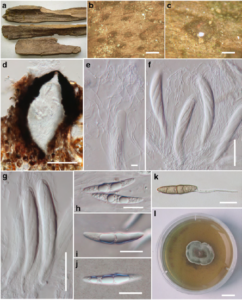Flammeascoma lignicola S. Boonmee & K.D. Hyde.
Index Fungorum number: IF551379; Facesoffungi number: FoF00852; Fig. 3
Etymology – Lignicola, referring to the habitat on wood.
Holotype – MFLU 10-0061
Saprobic on dead wood in terrestrial habitats. Sexual morph: Ascomata (173-) 278 – 362 μm high × 108 – 259 μm diam. (x̄ = 297 × 192 μm, n = 5), immersed, erumpent through the host tissue at maturity, scattered, subglobose to ovoid, carbonaceous, dark brown, with a small, ca. 9 – 10 μm diam. ostiole. Peridium 30 – 40 μm wide, comprising carbonaceous, occluded dark cells, easily cracking. Hamathecium comprising 0.5 – 1 μm wide, numerous, filiform, septate, branched, pseudoparaphyses, anastomosing between and above the asci. Asci (121-) 128 – 163 × 18 – 24.5 μm (x̄ = 143 × 21.5 μm, n = 20), 8 – spored, bitunicate, cylindrical to subclavate, apedicellate, rounded at the apex, with an ocular chamber. Ascospores 46 – 55 × 10 – 13 μm (x̄ = 52 × 11.5 μm, n = 20), overlapping biseriate, ellipsoid-fusiform, tapering towards the sub-acute ends, slightly curved, 1-septate, not constricted at the septum, hyaline, later becoming olivaceous-brown at maturity, containing two refractive globules when immature, lacking a mucilaginous sheath, smooth-walled. Asexual morph: Undetermined.
Culture characteristics – Ascospores germinating on MEA within 36 h. Colonies growing on MEA, rather slow-growing, reaching 0.2 mm diam. in 1 week at 28 °C. Mycelium superficial, felty, gummy, edge undulate, brownish grey, olive brown.
Material examined – THAILAND, Chiang Mai, Mae Taeng, Huai Nam Dang, on dead wood of Pinus L. (Pinaceae), 8 September 2009, Saranyaphat Boonmee, HND-01 (MFLU 10-0061, holotype); ex-type living culture, MFLUCC 10-0128, IFRDCC 2200.
Notes – Phylogenetic analysis of LSU and TEF sequence data indicates that Flammeascoma lignicola belongs in Anteagloniaceae (Figs. 1 and 2). Flammeascoma lignicola is closely related to F. bambusae Phookamsak & K.D. Hyde (Liu et al. 2015) with moderate bootstrap support. However, F. lignicola differs from F. bambusae in having uniloculate, carbonaceous ascomata, in lacking a sheath and in having larger ascospores (Fig. 3).

Fig. 1 (continued)

Fig. 2 Phylogram generated from Maximum Parsimony analysis based on combined LSU and EF sequence data of Anteagloniaceae and other related families. Parsimony bootstrap support values for MP≥70 % are shown above the nodes and Bayesian posterior probabilities ≥95 % are indicated in bold branches. The tree is rooted with Delitschia winteri CBS 225.62 (Delitschiaceae). All ex-types and reference strains are in bold and new isolate is in blue.

Fig. 3 Flammeascoma lignicola(holotype). a Specimens b, c Appearance of ascomata on wood and close up of ascoma erumpent through the host tissues d Section of ascoma and peridium e Pseudoparaphyses f g Asci. h – j Ascospores — note j stained in India Ink k Germinating ascospore l Colony on MEA. Scale bars: b = 200 μm, c –d = 100 μm, e = 5 μm, f – g = 50 μm, h – k = 20 μm, l = 10 mm.
